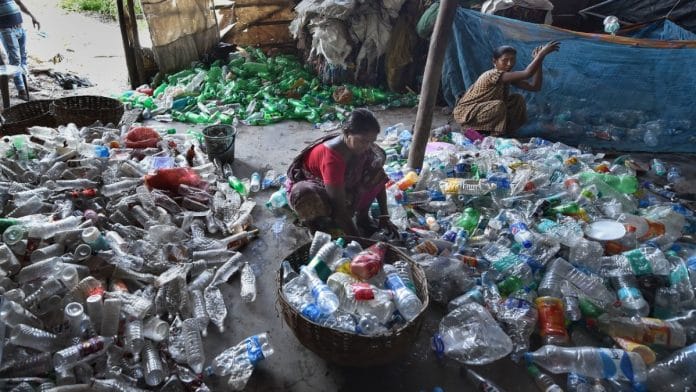Single-use plastic usage has soared during the past 50 years, infiltrating many aspects of our lives. Growing up in Armenia, when it was part of the former Soviet Union, plastic bags or plastic bottles were a rarity, and reusable shopping bags and glass bottles were the norm. Reuse was an accepted way of life. Now, in Armenia, like many nations around the world, single-use plastic is ubiquitous in daily life.
The facts are alarming. Today, single-use plastic covers the Earth, and its consumption is on track to skyrocket – from 460 million tonnes in 2019 to 1,231 million tonnes in 2060, threatening our ecosystems. Plastic, a byproduct of fossil fuels, also contributes to climate change. This is a double blow to planetary health.
Currently, half of global plastic production is for single-use, and 14% of plastic packaging is collected for recycling. For example, in the United States, where I currently reside, plastics use has tripled since the 1980s. However, only 5-6% of municipal plastic waste was recycled in 2021. Despite citizens separating their plastic waste, the bitter truth is that they are only preparing it for its journey to landfills, incinerators or the ocean.
As a society, we cannot recycle our way out of plastic waste. Alternative solutions are needed. It’s time to bring reuse back. Research shows that reusing just 10% of plastic packaging would reduce the plastic waste reaching the ocean annually by 50%.
Circular models of consumption gaining momentum
The good news is that the reuse trend – a circular model of consumption in which items are kept in use instead of tossed away – is finally gaining momentum.
In the private sector, for example, companies including PepsiCo and Coca Cola have announced industry-leading reuse targets. In the public sector, the European Union recently released the Packaging and Packaging Waste Regulation (PPWR) with proposed reuse targets across select industry sectors, and negotiations are ongoing at the United Nations to develop a legally binding agreement to end global plastic pollution.
As new business models and capabilities are developed to advance reuse, global actors must align on reuse success metrics. As such, it is an imperative that reuse is measured in a harmonized way to avoid fragmentation in target-setting and measurement of progress.
Equally important, it is critical that this harmonized measurement approach is first tested in “real world settings” by businesses, to ensure its accuracy and effectiveness before being used to inform the work of governments and standard-setting institutions, and scaled broadly across geographies, sectors and products.
To ensure a future where reuse measurement and reporting is consistent, the World Economic Forum’s Future of Consumption Platform has catalysed a coalition of leading private and public stakeholders that include organizations including PepsiCo, The Coca-Cola Company, Nestlé, Unilever, Walmart, the Ellen MacArthur Foundation, Greenpeace and the World Wildlife Fund (WWF), to build a comprehensive measurement and reporting framework for businesses to track progress towards reusable models of consumption.
Future of Consumption Platform outlines reuse metrics
The first phase of this effort resulted in the prioritization of two reuse metrics for corporate stakeholders to test in 2023. The first one measures the transformation of packaging portfolios designed for reuse, while the second captures whether consumers are effectively engaging with reuse models.
These two methodologies translate into measuring reuse both by share of volume or product units (i.e., litres of beverage, kilos of food, or litres of personal and home care products) as well as by the total number of loops a packaging unit achieves over its life, respectively.
The combination of these metrics is particularly important in holistically showcasing a company’s shift towards circular models, the ultimate sign of positive impact. A Reuse Metrics Testing Playbook offers detailed steps to guide businesses in their piloting efforts.
Walmart will also be testing the metrics against its new reuse pilot with Loop in Arkansas, where consumers will be able to have an assortment of products delivered in reusable containers through Walmart+ InHome.
Innovative solutions – along with getting reuse target-setting and measurements right – are the key steps in scaling reuse models globally and bringing reuse consumption back into practice.
This article originally appeared on Yicai Global
Zara Ingilizian, Head of Shaping the Future of Consumption; Member of the Executive Committee, World Economic Forum






